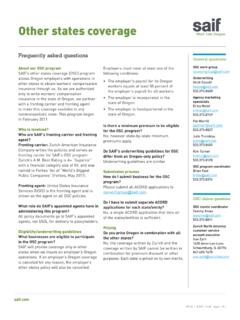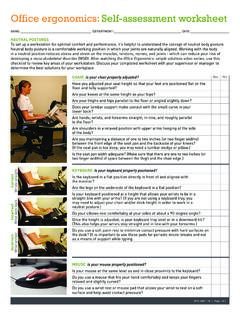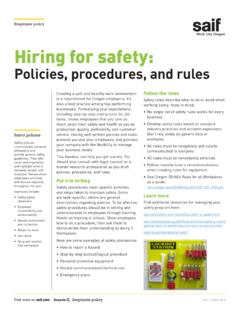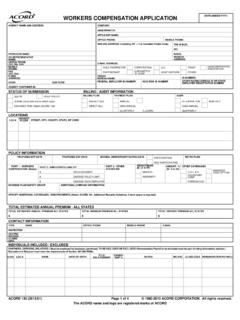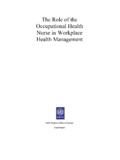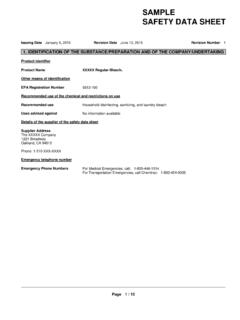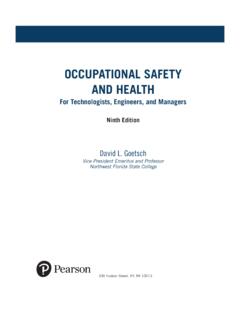Transcription of Lighting for Office and Industry - SAIF
1 INDUSTRIAL hygiene Lighting for Office and Industry Resources and information for developing Patient handling programs in health care SS-405 October 2018 Industrial hygiene Lighting for Office and Industry SS-405 | October 2018 Page | 2 Introduction Adequate, well-balanced levels of illumination are essential in establishing safe and productive working conditions, and for minimizing complaints due to sub-standard Lighting . Optimizing Office and industrial Lighting requires consideration of work tasks, environmental conditions, and economic considerations. The benefits of adequate Lighting include greater productivity and accuracy, improved safety and security, and improved morale. A complete Lighting survey requires evaluating several factors: the task, the working environment, and the quantity and quality of Lighting . General Lighting Adequate general and local Lighting is needed for rooms, buildings, and work areas during the time of use.
2 Factors used to control the adequacy and effectiveness of illumination include the following: Quantity of light The required quantity of light (illuminance) depends mostly on the visible task, the time allotted to perform the task, the worker, and the importance of the various task parameters. Recommended light levels are presented in the table below. This information was modified from the IESNA Lighting Handbook. 9th ed. Illuminating Engineering Society of North America, 2000. pp. 10-13. /Adapted with permission from the Canadian Centre for occupational Health and Safety (2011). Recommended Lighting Levels (lux*) Performance of visual tasks of high contrast or large scale 200 500 Performance of visual tasks of medium contrast or small size 500 1000 Performance of visual tasks of low contrast or very small size 1,000 2,000 *Lux = Lumens (quantity of light) per square meter Industrial hygiene Lighting for Office and Industry SS-405 | October 2018 Page | 3 The American National Standard Practice for Office Lighting (ANSI/IESNA RP-1-04) recommends that the average illuminance levels in offices where computer tasks predominate should not exceed 500 lux to minimize screen contrast.
3 If reading, note-taking, etc., are also performed (work that requires higher illuminance levels), task Lighting should be used. The Illumination Engineering Society of North America (IESNA) states consideration should be given to both color temperature and color rendition. Preferences for warm or cool light sources are related to culture or climate, so it is difficult to recommend color temperatures for all Office spaces. In general, lamps with a CRI of 70 or greater should be used to achieve reasonable comfort levels, or those with a CRI of 85 or above if color-critical tasks are being performed. Quality of light (flicker and glare, contrast and shadows) While the quantity of light is commonly recognized as important, factors influencing the quality of light have a significant impact. These factors include flicker and glare. Flicker Light flicker refers to quick, repeated changes in light intensity light that appears to flutter and be unsteady.
4 Although lights flicker on and off due to alternating current, the flicker rate is normally too fast to be detected. Flicker is a more common problem in Lighting with ballasts, like fluorescent lights, particularly for older lights with magnetic ballasts. For this reason, upgrades to fluorescent light fixtures commonly include replacing magnetic ballasts with electronic ballasts, which are essentially flicker-free. Electronic ballasts are also less likely to produce a noticeable hum and are more energy efficient. Although the human eye cannot see fluorescent light flicker, some individuals can somehow detect the flicker. This can result in complaints of headache, eye strain, and general eye discomfort. Studies have linked fewer complaints of eye strain and headaches with use of electronic ballasts in fluorescent lights and to increased use of natural Lighting .
5 Other steps to reduce flicker include: Replacing bulbs routinely, since older bulbs are more likely to flicker and may emit less light. Ensuring that light fixtures, particularly the ballast, are functioning properly. Upgrading fluorescent Lighting to those that use electronic ballasts when replacements are needed. Industrial hygiene Lighting for Office and Industry SS-405 | October 2018 Page | 4 Glare Glare is a common Lighting problem that occurs when a bright light source or reflection interferes with the ability to see an object. In addition to decreasing the ability to see, glare can cause annoyance and discomfort. There are two types of glare: direct or reflected. Direct glare is typically caused by sun or Lighting that is positioned to shine directly into someone s field of vision. A good test for direct glare is to stare at an object in the distance, and cover up a light source between the source and the eye.
6 If the object can now be seen more easily, the light source is probably a source of glare. Indirect glare can be caused by light reflected off of polished, shiny, or glossy surfaces, or from reflection off of glass surfaces (windows, picture glass) or computer monitors. To detect reflected glare, look at a task (for example, the desktop or computer monitor) from a normal working position. Block the light from the source to the potential source of reflection. If details are now more easily seen, reflected glare is a problem. General measures to reduce glare are: Having multiple small lights rather than one big one Keeping Lighting at recommended levels Positioning light fixtures, work surfaces, or computer monitors to reduce light that reflects into eyes Locating work area so that windows and fluorescent lights are parallel to line of sight Keeping surfaces as shine-free as possible (matte finish paints, non-reflective surfaces, etc.)
7 Moving shiny objects out of view of work areas Degree of contrast and shadows There should be good contrast between objects of interest and background ( , print versus paper, characters on a computer monitor versus background). Greater Lighting in areas next to, but outside of, the immediate work environment can make visibility difficult. Configure work area set-up or Lighting placement to avoid shadows within the work environment. Industrial hygiene Lighting for Office and Industry SS-405 | October 2018 Page | 5 Factors affecting sight In addition to the quality and quantity of Lighting , other factors influence sight. These include: 1. Size of the object or print 2. Time available to see the object 3. Age factors: pupil size, vision ability, and visual accommodation Regulatory requirements General regulatory requirements Oregon OSHA has promulgated a standard for illumination in Subdivision J, 437-002-0144, Additional Oregon Rules for General Environmental Controls.
8 (1) Illumination. (a) Adequate general and local light shall be provided for rooms, building, and work areas during the time of use. (b) Factors upon which the adequacy and effectiveness for illumination shall be judged include the following: (A) The quantity of light as specified in American National Standard ANSI , American Standard Practice for Industrial Lighting , (B) The quality of light in terms of freedom from glare, and correct direction, diffusion, and distribution. (C) Freedom from shadows and extreme contrasts. (c) All skylights, side windows, lamps, and other accessories that are necessary for illumination shall be kept clean, and in working order. Further information from Oregon OSHA on compliance expectations regarding Lighting can be found in the Oregon OSHA Lighting Program Directive A-66. Office requirements Recommendations for Office Lighting can be found on the Federal OSHA website, in the Computer Workstations eTool.
9 # Lighting Industrial hygiene Lighting for Office and Industry SS-405 | October 2018 Page | 6 Industrial requirements The regulation that addresses manlift use has specific requirements for illumination, which includes a 5 foot-candle minimum on each floor landing during use (see Oregon Administrative Rules, Subdivision F, ). Lighting standards for specific industries such as foundries, dairies, bakeries, sheet metal works, etc. can be found in Annex A2 and A3 of the most recent version of ANSI/ IESNA RP-7. This document outlines ranges of illuminance for specific tasks or locations within each Industry . Note: These are voluntary standards, not regulations. Emergency, safety, and security Lighting Emergency Emergency Lighting requirements are often covered by codes or local ordinances that detail the light levels, the length of time the Lighting must function under loss of power, and the acceptable types of power supplies.
10 Reference to these codes and ordinances is critical to ensure compliance with them. Safety Safety Lighting is required at all times when the building or outdoor space is occupied. This is the amount of Lighting that will allow occupants to safely move through the space under normal conditions. Recommendations for safety Lighting from the ANSI/IESNA RP-7 standard are: Low hazard environment/ Low activity Lux ( Foot-candles) Low hazard environment/High activity 11 Lux (1 Foot-candles) High hazard environment/Low activity 22 Lux (2 Foot-candles) High hazard environment/High activity 54 Lux (5 Foot-candles) Security The function of security Lighting includes protecting property, discouraging trespassers, and providing a means for identifying employees. Considerations include working with local law enforcement and property owners.



